- Details
- Hits: 6999
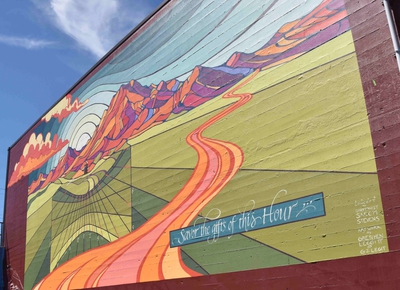 The Sundial Mural Project has been completed. Sasch Stephens of NW Sunworks spent years putting this project together and in association with Allied Arts sponsored an international competition that ultimately commissioned Gretchen Leggitt to paint a beautiful 30' x 60' wall mural incorporating the dial. The bright and engaging sundial mural is located on the south facing wall of 207 Unity Street in Bellingham, WA.
The Sundial Mural Project has been completed. Sasch Stephens of NW Sunworks spent years putting this project together and in association with Allied Arts sponsored an international competition that ultimately commissioned Gretchen Leggitt to paint a beautiful 30' x 60' wall mural incorporating the dial. The bright and engaging sundial mural is located on the south facing wall of 207 Unity Street in Bellingham, WA.
The dial and mural will be dedicated at noon Saturday, September 22, 2018 which coinsides with the date of the fall equinox. Called the "First Shadow Celebration" city council officials and noted sudialists will be present, as will Mataio Gills, co-owner of Ciao Thyme, the building that supports the mural and vertical dial. There will be music, entertainment, information about sundials, sundial kits, and a celebration of Solar Noon on the Equinox as seen on this major vertical sundial.
If you are in the Seattle-Bellingham-Vancouver area, head for the sundial dedication and First Shadow Celebration on the equinox, Saturday, Sept 22.
- Details
- Hits: 7591
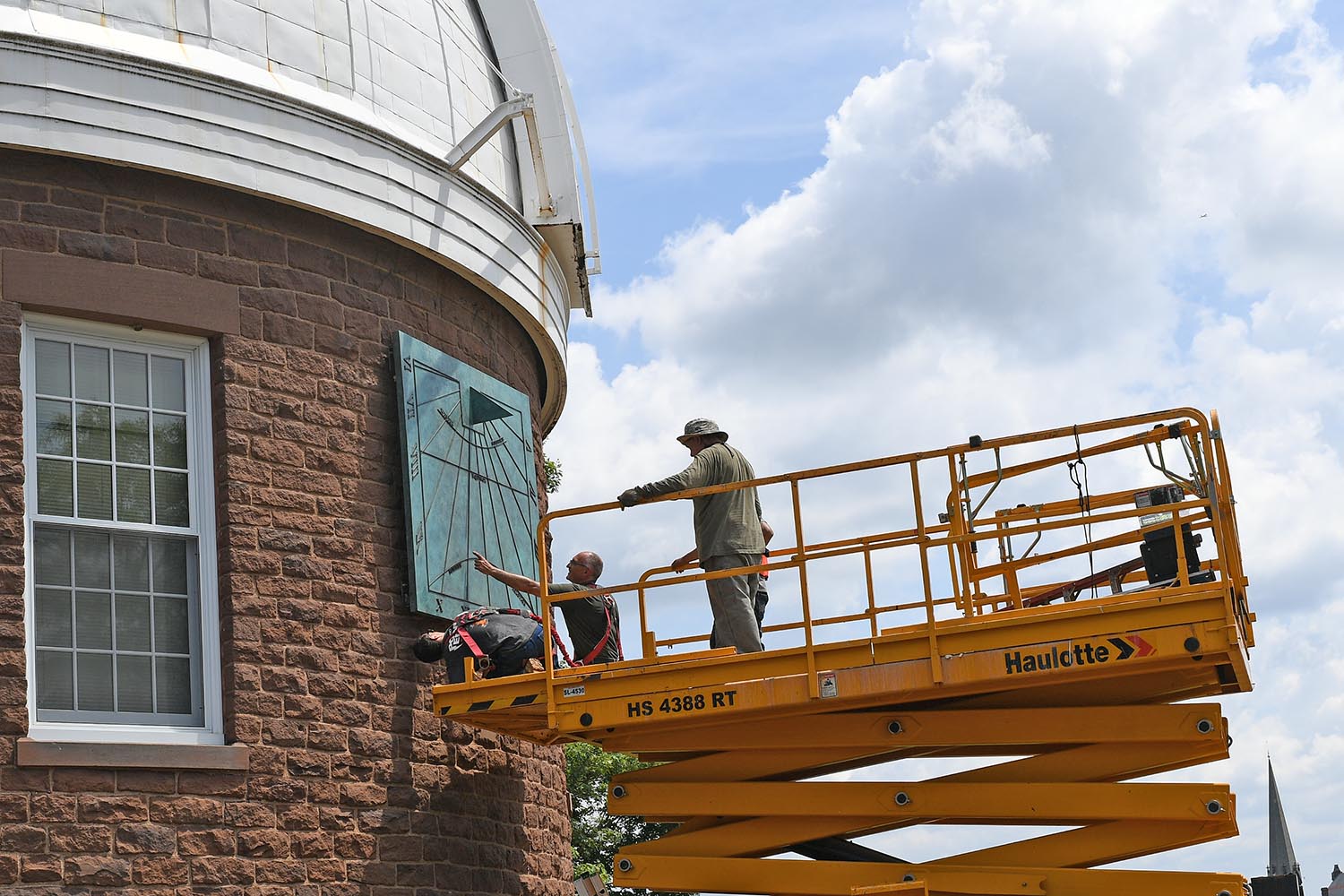 The Van Vleck Observatory has received a new sundial. In the Wesleyan news letter article by Olivia Drake who interviewed provost Joyce Jacobsen who said, "Campus doesn’t have enough outside art. A sundial is a perfect piece because it’s not only aesthetically pleasing but it’s functional too.” (https://newsletter.blogs.wesleyan.edu/2018/07/17/sundial-sculpture-installed-on-van-vleck-observatory/)
The Van Vleck Observatory has received a new sundial. In the Wesleyan news letter article by Olivia Drake who interviewed provost Joyce Jacobsen who said, "Campus doesn’t have enough outside art. A sundial is a perfect piece because it’s not only aesthetically pleasing but it’s functional too.” (https://newsletter.blogs.wesleyan.edu/2018/07/17/sundial-sculpture-installed-on-van-vleck-observatory/)
The 6 x 6 foot Muntz metal bronze sundial with stainless steel reinforcing weighing 650 pounds was carefully installed on the southern face of the 20-inch Clark Refractor dome on Foss Hill, Middletown, CT. The Alvan Clark telescope now open for public viewing was installed in July, 1922. In 1971 the Van Vleck observatory acquired the 24-inch Perkin reflector, housed in a separate dome near the west end of the old observatory building. (http://www.wesleyan.edu/astro/van-vleck/history.html)
The July 16th, almost exactly 96 years since the installation of the Clark telescope, the dome was graced by a sundial. Installation was supervised by the designer and creator, Robert Adzema (standing on the platform). He visited the campus multiple times with paper and wooden models seeking the right esthetic design. The final dial design is a true south declining sundial (notice the equinox line is parallel to the ground) but the hour lines are corrected for the longitude 72° 39.5585' W such that mean noon occurs 9m 22s after local mean noon. Hence a slight counter-clockwise twist to the hour lines (the 6am hour line is slightly below the horizontal). The shadow of the gnomon's tip traces the solstices and equinox. "I wanted the design to look timeless and in keeping with the classical nature of the building,” said Adzema. In Drake's article Adzema further commented on the patina of the bronze dial, saying, "I chose this green because it is the natural color bronze would oxidize over time. It is also a shade that looks great against the color of the observatory’s brownstone walls...The biggest difficulty was achieving the patina, which had to be applied by heating the surface of the dial and applying various chemicals and acids.”https://newsletter.blogs.wesleyan.edu/2018/07/17/sundial-sculpture-installed-on-van-vleck-observatory/
- Details
- Hits: 6583
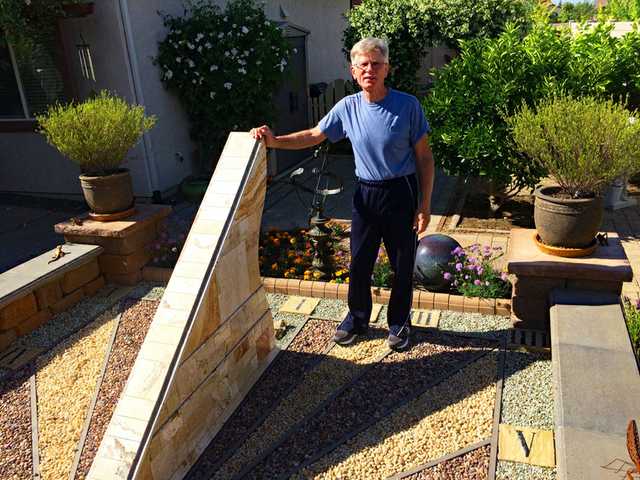 In a sunny corner of Ken & Molly Cooper's garden, located at their home in the Del Webb community of Manteca, CA, is an 8x12 foot horizontal sundial. The hours lines are delineated by alternating light tan and red stone pebbles. The hours themselves are squares of marble with Roman numerals from 6am to 6pm. The 4 foot gnomon is about six inches wide, made of a concrete core and flanked with marble. The hour lines are correctly laid out for a thick gnomon.
In a sunny corner of Ken & Molly Cooper's garden, located at their home in the Del Webb community of Manteca, CA, is an 8x12 foot horizontal sundial. The hours lines are delineated by alternating light tan and red stone pebbles. The hours themselves are squares of marble with Roman numerals from 6am to 6pm. The 4 foot gnomon is about six inches wide, made of a concrete core and flanked with marble. The hour lines are correctly laid out for a thick gnomon.
Surrounding the dial is a low brick wall decorated with lizards and butterflies. According to Rose Alban Risso, correspondent for the Manteca Bulletin, "The central focus [of the garden], a huge sundial that took him hundreds of hours to make, is the realization of a childhood dream and fascination with astronomy. The two concrete spheres here were hand painted by the retired PG&E employee. One is designated as the night sky and the other represents daytime. An armillary time piece occupies another corner of the sundial..."
- Details
- Hits: 5907
Normally when one mentions a human sundial, we think of an analemmatic dial carefully painted on the ground with a himan gnoman standing carefully on a date in the central walkway. But you can design a sundial that works for a day or two by just having a central platform, standing on it to become a gnomon, and letting your shadow fall on marked hours drawn on the ground below. But would you stand there all day? NASA presented their Astronomical Picture of the Day showing that "on July 19th, the Astronomy Group of students in the Progymnasium Rosenfeld created a human sundial, each participant patiently playing the role of a gnomon for 10 minutes. In this timelapse video of their temporal voyage of discovery, one image was taken every 20 seconds from 8 amuntil4 pm Central European Summer Time. Drawn on the ground are the dial hour marks calculated to show the local time for that specific date. Behind, the tower clock offers a time check... The group plans a repetition of this performance next winter to compare the length of the day and the altitude of the sun."
Video by permission of Astronomie-AG, Progymnasium Rosenfeld, Till Credner, AlltheSky.com
- Details
- Hits: 7683
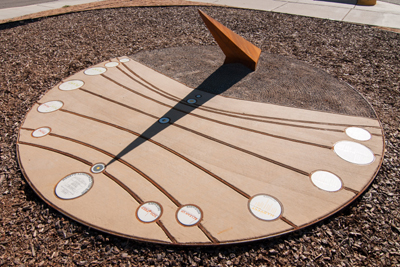 Sad note: A recent check of Google shows that the dial was removed in early 2016 and the lot that supported garden education is now a housing complex.
Sad note: A recent check of Google shows that the dial was removed in early 2016 and the lot that supported garden education is now a housing complex.
In a small park at the intersection of Morningside Dr SE and Silver Ave SE in Alburquerque, NM. is a unique horizontal sundial designed for the Nob Hill Main Street program, where the 10-foot diameter sundial anchors the southeast corner of the Nob Hill Community Garden. Created several years ago by Mike Heighway and Mira Rose, Mike explains, "The purpose of the Nob Hill Sundial is to act as an interactive gardener’s guide. It works on an annual cycle by casting a shadow from a large center piece (the gnomon) onto a concrete plate with embedded steel [diurnal] bands and porcelain tiles that describe that month’s gardening activities."
The sundial acts as an educational tool for gardeners to show what to plant throughout the year, and when to harvest. Instructions are on porcelain tiles. There are a total of 17 tiles — one tile for each month of the year, one winter solstice tile, one summer solstice tile, one tile for both equinoxes, a centering tile (the tile which dictates the very center of the design), and a "hero" tile in the shape of a historic U.S. highway sign with information about contributors to the project. Most prominent is the acknowledgement of the Garden Design by Robert Strell and Grant Funding from the New Mexico Centennial Foundation.
Read more at http://www.mikeheighway.com/projects/nhsd.html
- Details
- Hits: 6327
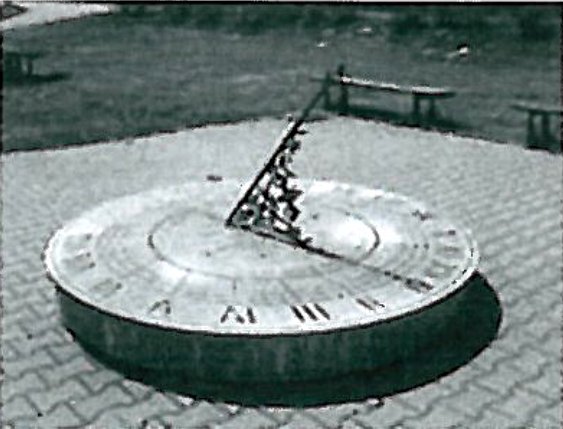
Photo: PL 664 Sundial at School in Janowice Janowice Rybnickie just south of Rybnik
|
The sundials working group of the Czech Astronomical Society in Hradec Králové organized a short study tour to Poland in June 2016 with a special emphasis on seeing sundials. This report is provided by Hohumil Landsman:
"The first stop was the Muzeum im. Przypkowskich, the world famous museum that began as the clock collection of the Przypkowski family. It is situated in the town square of Jędrzejów. As well as various fixed and portable sundials, the museum showed devices for the construction of sundials and several old books on astronomy and gnomonics."
"From there we visited the Planetarium and Observatory of Youth in Niepołomice. Among other things, there were commentaries available for blind visitors for whom the spoken word is a principal source of information. Another interesting stop was the Silesian Planetarium and Astronomical Observatory of Nicolaus Copernicus in Chorzów. In the courtyard of the planetarium there is a large sundial showing local solar time, and in the basement we found a seismological station containing two early 20th-century seismographs as well as their more modern equivalents. A meteorological station forms part of the same complex of buildings. As an additional diversion, we also visited the salt mines in Wieliczka."
- Details
- Hits: 8124
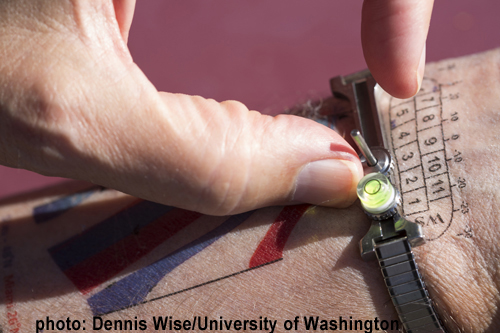 Woodruff (Woody) T. Sullivan III hosted two NASS conferences, one in 1998 and a second in 2011, each time showing many new Seattle sundials...most of which he had a helping designer's hand. Woody made T-shirts proclaiming "Seattle - sundial capital of North America". Now in the on-line University of Washington Today for December 1, 2016, Peter Kelley profiled Professor Emeritus Sullivan, noting the many worlds of interest by the UW astronomer and astrobiologist...including his passion for sundials. In Kelley's interview Woody expounded "My sundial interest began very specifically in 1991. I got interested because three years before we moved in to the new Physics-Astronomy building in 1994, the architects asked , what do you want? I'm thinking of my interest in history of science and art and design, so I casualy said, 'A sundial would be nice'. Since then, it's hard to believe - like getting married - that there's a phase in my life before that."
Woodruff (Woody) T. Sullivan III hosted two NASS conferences, one in 1998 and a second in 2011, each time showing many new Seattle sundials...most of which he had a helping designer's hand. Woody made T-shirts proclaiming "Seattle - sundial capital of North America". Now in the on-line University of Washington Today for December 1, 2016, Peter Kelley profiled Professor Emeritus Sullivan, noting the many worlds of interest by the UW astronomer and astrobiologist...including his passion for sundials. In Kelley's interview Woody expounded "My sundial interest began very specifically in 1991. I got interested because three years before we moved in to the new Physics-Astronomy building in 1994, the architects asked , what do you want? I'm thinking of my interest in history of science and art and design, so I casualy said, 'A sundial would be nice'. Since then, it's hard to believe - like getting married - that there's a phase in my life before that."
That UW sundial was a large vertical decliner, entered in the NASS Sundial Registry as Dial #117. But now a new precision sundial...using an arm tattoo. Woody explained, "This started with a paleontologist graduate student in the astrobiology program. She likes sundials and we got talking and over the last couple of years we designed [a tattoo sundial]. The idea was for her to have it, but she how has her degree and has since left town. Meanwhile I said to myself, dammit - that would be pretty neat. In April I gave a talk to the British Sundial Society about the technical details and showed the decal I'd made for my inner forearm. I'm going to write it up for their publication. The world's first working sundial tattoo!"
Read more at:: http://www.washington.edu/news/2016/12/01/the-many-worlds-of-uw-astronomer-and-astrobiologist-woody-sullivan/
- Details
- Hits: 10320
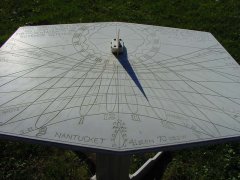 More than 25 years ago Robert diCurcio made a compound sundial. A small round horizontal dial is surrounded by a larger gnomonic dial engraved with hour lines in the shape of analemmas. Careful inspection of the dial shows that the lines are offset from the longitude of 70 degrees to account for the sun at the eastern time meridian of 75 degrees west. In "Yesterday's Island - Today's Nantucket" Katherine Brooks of the Maria Mitchell Association (MMA) takes a close look at the sundial in their front yard, sitting on the lawn of the Maria Mitchell Observatory on Vestal Street.
More than 25 years ago Robert diCurcio made a compound sundial. A small round horizontal dial is surrounded by a larger gnomonic dial engraved with hour lines in the shape of analemmas. Careful inspection of the dial shows that the lines are offset from the longitude of 70 degrees to account for the sun at the eastern time meridian of 75 degrees west. In "Yesterday's Island - Today's Nantucket" Katherine Brooks of the Maria Mitchell Association (MMA) takes a close look at the sundial in their front yard, sitting on the lawn of the Maria Mitchell Observatory on Vestal Street.
Here is a slight correction to the article's text: diCurcio set up the sundial perfectly level and oriented it so that the meridian-line is exactly north-south. [Hopefully aligned to true north, NOT magnetic north.] Once the dial is aligned the triangular gnomon will cast a shadow not only for the small horizontal dial telling east coast solar time, but the tip of the gnomon shadow points to the analemma, the “figure of eights”, which shows standard or daylight mean time (clock time). Installed by diCurcio, the sundial at the Maria Mitchell Association is accurate to this day. Brooks writes,"We hope you stop by the Maria Mitchell Vestal Street Observatory on Vestal Street to see the 1908 observatory built by the MMA and to test out the Sun d’Isle on the lawn in front. If reading shadows interests you, we encourage you to attend our Summer Speaker Series this Tuesday, August 30,[2016] to learn about the “Effects of Light at Night” with Dr. Mario E. Motta."
Compare the photo of the MMA sundial from Brook's article http://yesterdaysisland.com/what-is-this-a-sundial/ with the sundial photo above that appears in the NASS Sundial Registry at http://www.sundials.org/index.php/component/sundials/oneDial/513
- Details
- Hits: 6225
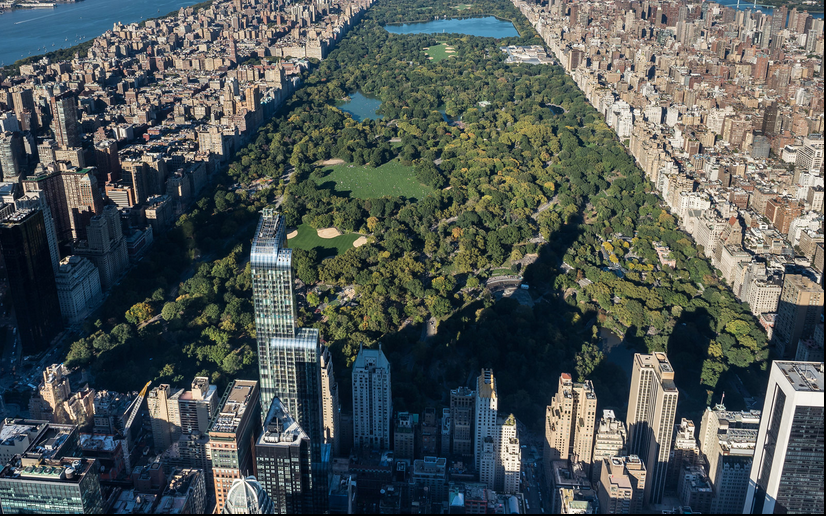 Michael Lee's photograph of Central Park started it all. Erika Owen (TravelandLeisure.com) wrote "If you think Central Park is only good for its slightly quieter reprieve from the hustle and bustle of the Big Apple, you're missing out. As it turns out, the park can actually be used as a giant sundial. Understandably, this isn't a universally accessible perk of the park...you'd need to be in an airplane or helicopter to truly appreciate the functionality."
Michael Lee's photograph of Central Park started it all. Erika Owen (TravelandLeisure.com) wrote "If you think Central Park is only good for its slightly quieter reprieve from the hustle and bustle of the Big Apple, you're missing out. As it turns out, the park can actually be used as a giant sundial. Understandably, this isn't a universally accessible perk of the park...you'd need to be in an airplane or helicopter to truly appreciate the functionality."
Any vertical ediface such as a tall building, a flagpole, or even the Washington Monument can become a gnomonic sundial measuring time by the tip of their shadow. But seeing those shadows on the ground results in fuzzyness of the penumbral shadow. The solution? Step back, way back to a perspective of seeing the shadows from high in the air. From this view these giant sundials become visible. Owen continues, "Billionaire's Row, the name given to the skyscrapers lining the two blocks south of the park between Fifth Avenue and Central Park West gives off plenty of shadows..."
To see the shadows in motion, Cube Cities presents a short video "Central Park Shadows". Cube Cities specializes in urban city representations and animation software to create them. For example they visualize the growth of cities as Manhattan from the 1920s and the growth of San Franciso from 1977 to 2015 and Chicago from 1862 to 2014.
